6+ Sample Nonprofit Crisis Communication Plan
-
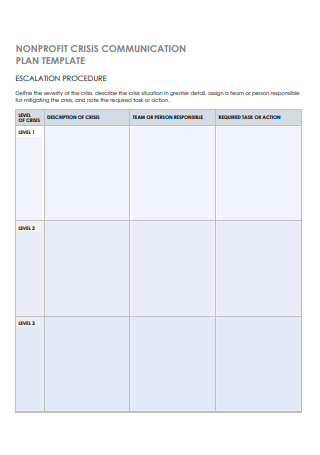
Nonprofit Crisis Communication Plan Template
download now -
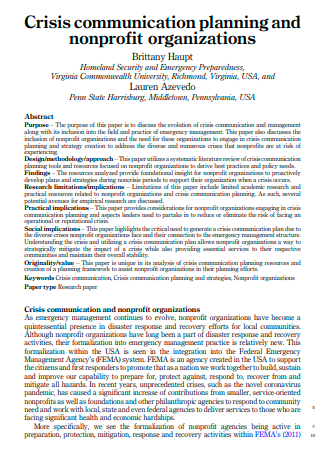
Nonprofit Organizations Crisis Communication Planning
download now -
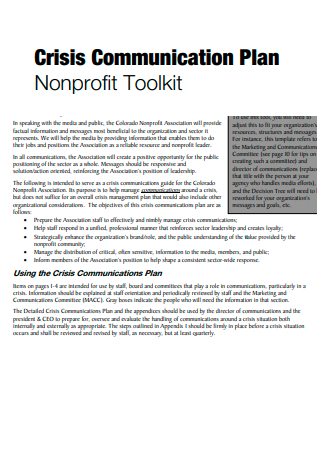
Nonprofit Crisis Communication Plan Example
download now -
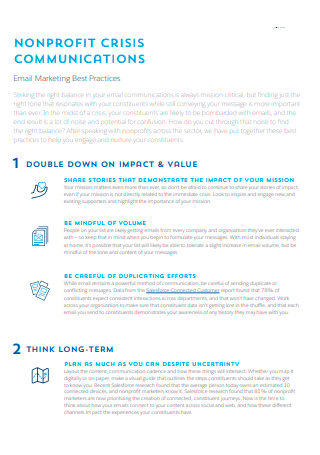
Printable Nonprofit Crisis Communication Plan
download now -
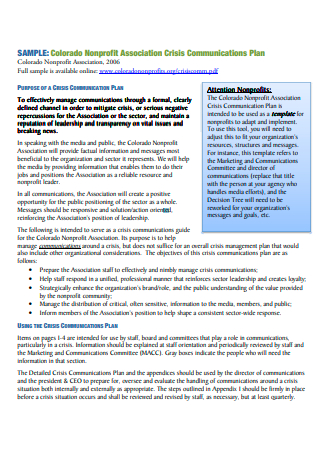
Nonprofit Association Crisis Communications Plan
download now -
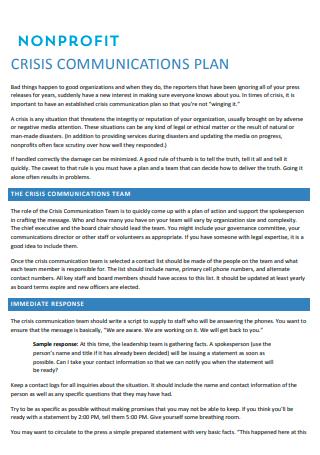
Nonprofit Crisis Communication Plan in PDF
download now -
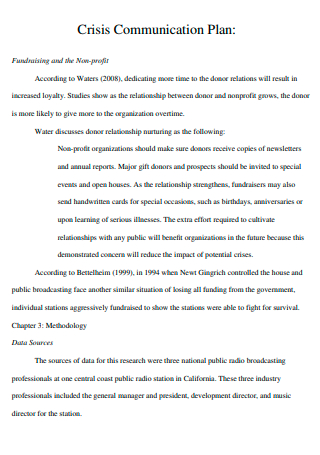
Fundraising and Nonprofit Crisis Communication Plan
download now
FREE Nonprofit Crisis Communication Plan s to Download
6+ Sample Nonprofit Crisis Communication Plan
What Is a Nonprofit Crisis Communication Plan?
What’s Inside a Crisis Communications Plan?
Steps in Creating a Nonprofit Crisis Communication Plan
FAQs
How important is media training during times of crisis?
Should you be proactive about a crisis?
Being in a crisis can be daunting. How do you remember what you are supposed to do in terms of communication?
But running a nonprofit organization is not always smooth sailing, because, as with any other type of organization that exists, problems are always bound to happen. They can sometimes range from something as simple as communication problems, scheduling problems, or personnel problems, or to something as bad as a full-blown crisis. In the case of the latter, how should a nonprofit organization deal with it? Luckily, with something as simple as a crisis communication plan, they have the opportunity to handle it properly and get the organization back on track as soon as possible. But what is this type of document?
What Is a Nonprofit Crisis Communication Plan?
Before we define the crisis communication plan, what is a nonprofit organization? Defined, it is a legal body that is created and operated for the benefit of the general public. They can take many forms, including informal neighborhood groups, food banks, and traditional charities, as well as labor groups, hospitals, and major colleges. Throughout its operational existence, they are obligated to make operational and financial information available to the public so that contributors may learn how and how well their donations have been used. To be officially recognized, the group must specifically indicate in its organizational documents that its operations will not be utilized for personal advantage or benefit for its members.
A nonprofit crisis communication plan is a business document that contains a set of measures that a nonprofit organization can take in the event of an emergency or other unforeseeable incident. It specifies the messaging that the organization will use, how they will communicate with and respond to the community, and, when relevant, the activities that they will take to guarantee the crisis doesn’t happen again. This sort of document can be utilized when a nonprofit organization is dealing with an internal difficulty (such as member conflicts) or an outside challenge (such as external malicious attacks or natural calamities).
What’s Inside a Crisis Communications Plan?
When a crisis strikes inside a workplace or within an organization, this type of document is needed so that the people within know how to deal with it and how to recover from it. This document must be easily understandable and must also contain certain elements for it to be effective. With that being said, here are the elements that make up a crisis communications plan:
Steps in Creating a Nonprofit Crisis Communication Plan
Here are the important steps to be followed when creating a nonprofit crisis communications plan; It is much better to have a plan prepared in advance so that in the event that a crisis actually arrives, the nonprofit organization will then know what to do during the crisis and once the crisis subsides.
1. Identify Key Personnel and Their Roles
This is the first step in creating the nonprofit crisis communication plan. In this step, determine the key personnel of your nonprofit organization and their respective roles should a crisis arise. Depending on the size of the nonprofit organization, this team may include solely the executive director, board members, and the head of marketing, but it may also include the HR staff, other members of the marketing team, or members of the team affected by the present problem. A primary spokesperson should be designated, and certain employees may be tasked to answer queries posted on the company’s social media profile. Additionally, ensure that a strategy to reach important team members after hours is present so that the appropriate message may be selected as quickly as feasible.
2. Perform an Assessment
The next thing to do after identifying key personnel and their respective roles is to perform an assessment of a potential crisis that can happen to your nonprofit organization. This step is essential because no matter how well-prepared your business is, there will always be components of the crisis communications plan that must be tailored to the specific scenario. In this step, consider whether anyone would be in imminent danger during the crisis, whether the staff will be properly informed about what is going on, whether who are the appropriate audiences that should be made aware of the situation in the organization, the actions available to minimize the effects of the crisis, and so on.
3. Identify the Communication Channels to be Used
After performing an assessment of the possible scenarios that can happen to your organization, this step will follow. In this step, decide on which communications channels are necessary for the crisis that may unfold and affect your nonprofit organization. Various levels of reactions will be required depending on the scenario. The crisis communications plan should include who is in charge of managing each situation and ways of determining the messaging channel as soon as possible, especially considering how rapidly news circulates on social media these days. Social media, email, and the organization’s website are all examples of communication channels. You’ll also need to establish how frequently you communicate on each channel. It can be done every hour, every few days, or once a week.
4. Monitor What’s Happening and What Can Happen
After identifying the communication channels that the organization can use with respect to the crisis scenario that can unfold, this step will then follow. In this step, keep in mind when making the crisis communication plan that certain issues may take more time to handle than others. It is important that a team member must be appointed in order to monitor the issue on social media as well as other outlets, if appropriate until everything is resolved. This way, access to real-time updates is possible concerning how the community and local government are responding and determine whether disclose of more information is required or taking further action is needed.
5. Stay in Touch With the Team
After monitoring the possible scenarios that can happen and that are currently happening, this step will then follow, which will also serve as the last. It is also critical to have mechanisms in place to allow for regular check-ins among the team in charge of resolving the crisis. That way, there is always an opportunity to improve the approach taken and guarantee it is as effective as possible for future situations. Once it has been determined that the crisis is finally finished, a more formal retrospective to determine what went wrong, what went correctly, and what your plan is lacking in order to manage it better the next time should be performed.
FAQs
How important is media training during times of crisis?
During a crisis, excellent communication skills are essential, and they can be obtained through proper media training. Media training is vital because it teaches representatives how to communicate with the media and the general public in difficult situations. Identify and give continuous training to those persons within your organization who may be able to effectively communicate with the media in the case of a crisis to increase the likelihood of communicating effectively during a crisis. Training is essential for employees who are responsible for speaking to the media because it teaches them the best techniques to communicate effectively with members of the media.
Should you be proactive about a crisis?
Yes, the organization should be proactive about a potential crisis and it is much better to be proactive about a potential crisis. Because prevention is better than cure, it’s a good idea for your organization to create a habit of discovering and fixing little issues before they escalate into something much more difficult to handle. Proactively seeking feedback from customers and monitoring what others are saying about your organization on social media and review platforms are two ways to be proactive. You’ll have an easier job keeping a favorable public impression if you take reasonable comments seriously and enhance your client experience accordingly.
Being in a crisis can be daunting. How do you remember what you are supposed to do in terms of communication?
When you are a part of a communications team handling a crisis in your organization, one thing that can aid you in remembering what you are supposed to do is a document called a media strategy checklist. This type of document can be important since it helps the team focus on the things that need to be covered while the crisis is going on around the organization. This can also be adaptable to the type of crisis that is currently unfolding, or a generic checklist may be used by the team.
A nonprofit crisis communication plan can prove to be essential to nonprofit organizations since it aids them to have a quick response and it also enables them to think clearly even during the most heated point of the crisis that can happen within the organization. The creation process of this may be intimidating to some nonprofit organizations. To aid in the writing process, sample templates are available in this article for download and viewing so that you can have a reference when writing one, making your writing process somewhat easier.
